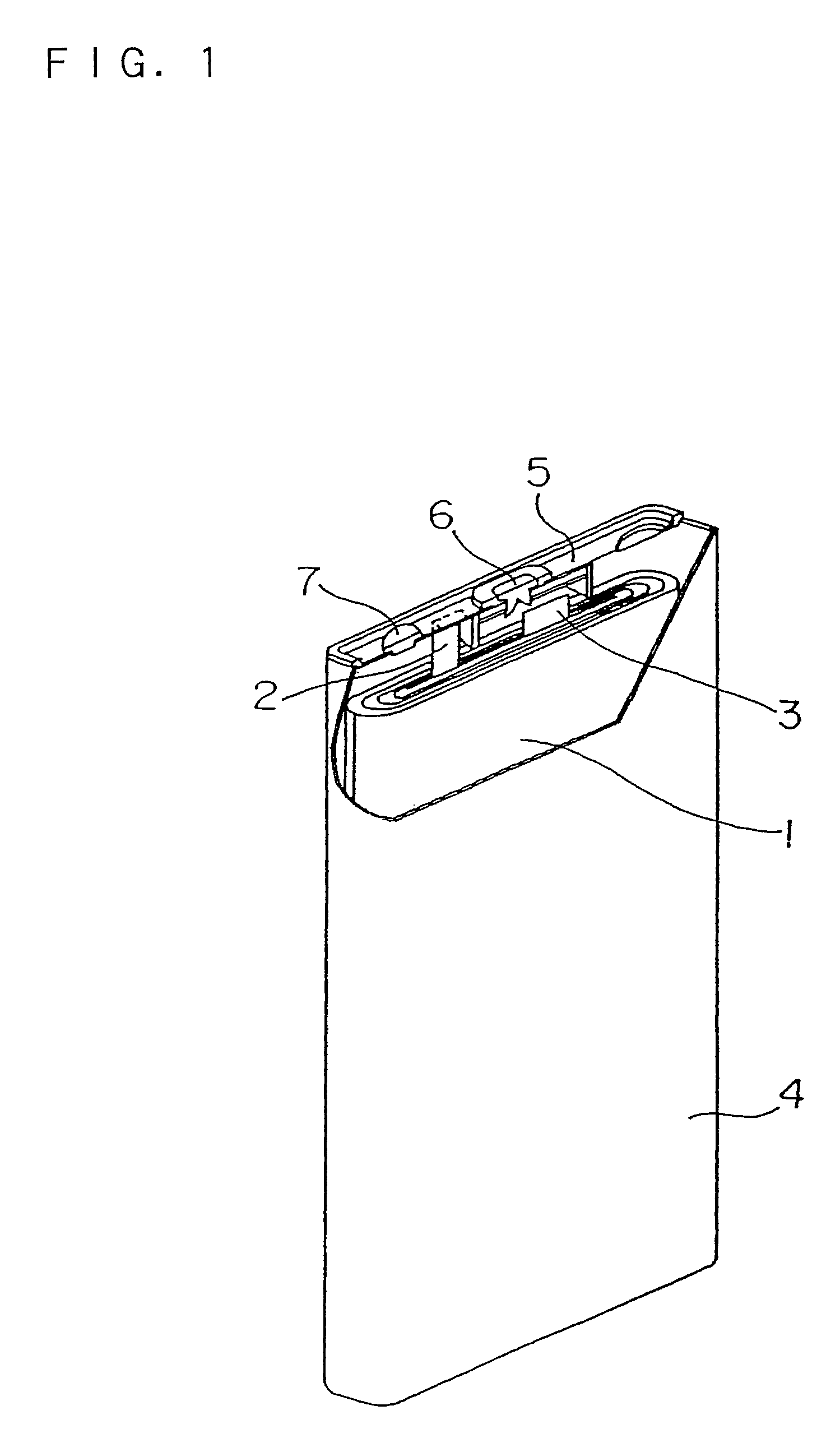Non-aqueous electrolyte secondary battery and electrolyte for the same
a secondary battery and non-aqueous electrolyte technology, applied in the direction of non-aqueous electrolyte cells, electrochemical generators, electrolytic capacitors, etc., can solve the problems of corroding aluminum, likely to increase the viscosity of a non-aqueous electrolyte, and the expansion of the battery itself. to achieve the effect of reducing the expansion of the battery
- Summary
- Abstract
- Description
- Claims
- Application Information
AI Technical Summary
Benefits of technology
Problems solved by technology
Method used
Image
Examples
example 1
(i) Production of Positive Electrode
[0041]A paste type positive electrode active material mixture was prepared by mixing 3 parts by weight of acetylene black as a conductive material, 4 parts by weight of polyvinylidene fluoride (hereinafter referred to as “PVdF”) as a binder and a proper amount of N-methyl-2-pyrrolidone (hereinafter referred to as “NMP”) with 100 parts by weight of lithium cobalt oxide (LiCoO2) as an active material. It is to be noted that PVdF was dissolved in NMP before its addition to other components. The obtained paste type positive electrode material mixture was applied onto the both surfaces of a titanium foil current collector, which was then dried and rolled out to give a positive electrode.
(ii) Production of Negative Electrode
[0042]A paste type negative electrode material mixture was prepared by mixing 3 parts by weight of styrene butadiene rubber as a binder in the form of an aqueous dispersion with 100 parts by weight of non-graphitizing carbon (Carbotr...
example 2
[0048]A non-aqueous electrolyte was prepared in the same manner as in EXAMPLE 1 except that 2 parts by weight of VC was added as an additive to 100 parts by weight of GBL. A battery analogous to that of EXAMPLE 1 was produced, except that the obtained non-aqueous electrolyte was used and flake graphite was used as a negative electrode active material instead of the non-graphitizing carbon (hard carbon). The obtained battery was referred to as “Battery of EXAMPLE 2”.
example 3
[0049]As a non-aqueous solvent, GBL was used singly. As a solute, LIFSI and LiPF6 were used at a molar ratio of 7:3. In this example, LiFSI and LiPF6 were dissolved in GBL at a concentration of 0.7 mol / L and 0.3 mol / L, respectively, to give a non-aqueous electrolyte. A battery analogous to that of EXAMPLE 2 was produced, except that the obtained non-aqueous electrolyte was used and an aluminum foil was used as a positive electrode current collector instead of the titanium foil. The obtained battery was referred to as “Battery of EXAMPLE 3”.
PUM
| Property | Measurement | Unit |
|---|---|---|
| boiling point | aaaaa | aaaaa |
| thickness | aaaaa | aaaaa |
| voltage | aaaaa | aaaaa |
Abstract
Description
Claims
Application Information
 Login to View More
Login to View More - R&D
- Intellectual Property
- Life Sciences
- Materials
- Tech Scout
- Unparalleled Data Quality
- Higher Quality Content
- 60% Fewer Hallucinations
Browse by: Latest US Patents, China's latest patents, Technical Efficacy Thesaurus, Application Domain, Technology Topic, Popular Technical Reports.
© 2025 PatSnap. All rights reserved.Legal|Privacy policy|Modern Slavery Act Transparency Statement|Sitemap|About US| Contact US: help@patsnap.com

